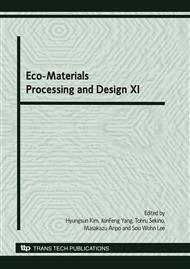p.185
p.189
p.193
p.197
p.201
p.207
p.211
p.215
p.220
Fabrication of Lotus-Type Porous Magnesium with Anisotropic Directional Pores by Mold Casting Technique
Abstract:
Lotus-type porous magnesium ingots were fabricated in pressurized hydrogen atmosphere through a mold casting technique. The mold consists of two cooling blocks placed at the bottom and one lateral side. It was found that the pores started to grow upwards and horizontally and the both directional pores collapsed and then shifted to the direction. Such anisotropic growth of pores is in good agreement with the map of temperature gradient predicted by two-dimensional finite differential analysis.
Info:
Periodical:
Pages:
201-206
Citation:
Online since:
July 2010
Authors:
Price:
Сopyright:
© 2010 Trans Tech Publications Ltd. All Rights Reserved
Share:
Citation:


